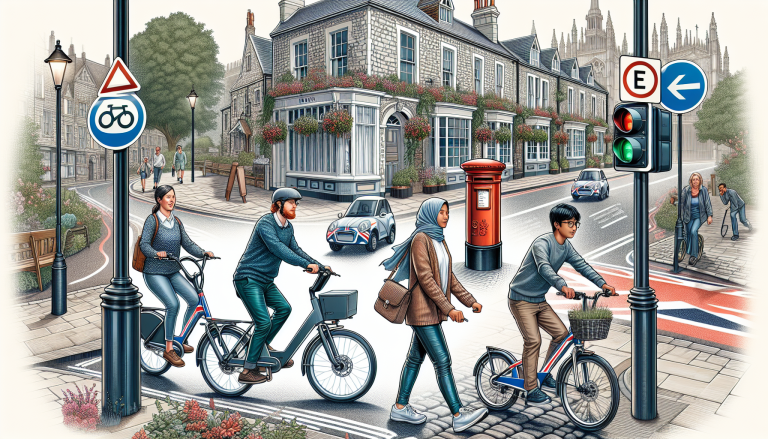Imagine riding your bike through the picturesque streets of the UK, enjoying the fresh air and the freedom that comes with cycling. As dusk settles in, you might start wondering about the legal requirement of having lights on your bicycle. Are you breaking the law if your bike isn’t equipped with lights? In this article, we will uncover the answer to this burning question and shed light on the regulations that govern cyclists and their illuminating companions. So, hop on your bike, fasten your helmet, and let’s find out if cyclists in the UK are legally obligated to have lights.
Table of Contents
ToggleOverview of Cycling Laws in the UK
Introduction to Cycling Laws
Cycling is a popular mode of transportation and recreational activity in the United Kingdom. As a cyclist, it’s important to be aware of and adhere to the cycling laws in order to ensure your safety and the safety of others on the road. One key aspect of cycling laws in the UK is the requirement for cyclists to have lights on their bicycles. In this article, we will provide an overview of the cycling laws in the UK, with a specific focus on the importance of lights for cyclists.
Cycling on Public Roads
When cycling on public roads in the UK, it is important to understand the legal obligations and responsibilities that come with it. Cyclists are considered vulnerable road users, and therefore, are subject to certain regulations to ensure their safety. One such regulation is the requirement for cyclists to have lights on their bicycles during specific times and conditions.
Importance of Lights for Cyclists
Lights play a crucial role in ensuring the safety of cyclists, especially during low visibility conditions such as dawn, dusk, and nighttime. They help increase the visibility of the cyclist to other road users, including motorists and pedestrians, reducing the risk of accidents and collisions. Lights also help cyclists to see the road, obstacles, and potential hazards more clearly, allowing them to react in a timely manner.
The Highway Code
Legal Obligations for Cyclists
The Highway Code is a set of guidelines and rules that govern the use of public roads in the UK. It establishes the legal obligations for all road users, including cyclists. According to the Highway Code, cyclists must have lights on their bicycles when cycling at night or in poor visibility conditions. Failure to comply with this requirement could result in penalties and could also compromise the safety of both the cyclist and other road users.
Requirements for Lights
To meet the legal requirements Rule 60 of the Highway Code states, cyclists must have both a white front light and a red rear light on their bicycles, lit between sunset and sunrise These lights should be positioned and visible from the front and rear respectively, ensuring maximum visibility for other road users. In addition to front and rear lights, cyclists are also advised to have reflectors on their bicycles to further enhance visibility.
Times When Lights Are Necessary
According to the Highway Code, cyclists are required to have lights on their bicycles from sunset to sunrise or in poor visibility conditions. This means that if you are cycling during the hours of darkness or when visibility is significantly reduced, lights on your bicycle are compulsory. It is important to prioritize safety and ensure your lights are functioning properly at all times.
Types of Lights
Front Lights
Front lights are essential for cyclists as they make the cyclists more visible to other road users and illuminate the road ahead. The front light should emit a white light and be capable of providing a steady beam, rather than flashing. It is important to choose a front light that is bright enough to be clearly visible to other road users, without causing discomfort or distraction.
Rear Lights
Rear lights are equally important as they ensure that cyclists are visible from the rear, reducing the risk of collisions with vehicles approaching from behind. The rear light should emit a red light and, like the front light, should have a steady beam rather than flashing. It is recommended to have a rear light that has multiple modes, including a flashing option, to further enhance visibility during low light conditions.
Reflectors
Reflectors are passive safety devices that can greatly enhance a cyclist’s visibility, especially when illuminated by headlights of other vehicles. They are typically attached to the bicycle, such as on the wheels, pedals, and rear of the bicycle. Reflectors reflect the light back to its source, making the cyclist more visible from multiple angles. While reflectors are not a replacement for lights, they can be a valuable addition to a cyclist’s safety gear.
Responsibilities of Cyclists
Installing and Maintaining Lights
As a cyclist, it is your responsibility to ensure that your lights are properly installed and well-maintained. Lights should be securely attached to the front and rear of your bicycle and should be checked regularly to ensure they are in good working condition. It is important to regularly check the batteries, replace them when necessary, and ensure that the lights are clean and free from any obstructions.
Proper Usage of Lights
Lights are only effective if they are used correctly. When cycling at night or in poor visibility conditions, ensure that your lights are switched on and are clearly visible to others. Use a steady beam rather than flashing lights, as this can be less distracting for other road users. It is also important to position the lights in a way that they are not obstructed by any accessories or equipment on your bicycle.
Visibility and Safety
Using lights is not just a legal requirement, but also a matter of personal safety. By prominently displaying lights on your bicycle, you are making yourself more visible to motorists, pedestrians, and other cyclists. This can help prevent accidents, as others will be able to see you from a distance and react accordingly. Always prioritize your visibility and take appropriate safety measures, including using reflective gear in addition to lights.
Exemptions and Exceptions
Daytime Riding
While having lights is mandatory during nighttime and poor visibility conditions, it is not required during daylight hours. However, it is important to note that even during the day, using lights can significantly increase your visibility, especially in challenging weather conditions or in areas with heavy traffic. Therefore, it is recommended to use lights during daytime riding to enhance your safety on the road.
Off-Road Cycling
Cycling off-road, such as on designated cycle paths or trails, does not require the use of lights. However, it is always advisable to have some form of lighting when cycling off-road, as it can help improve visibility and assist you in navigating through potentially hazardous terrains. Be considerate of other users and ensure your lights do not cause discomfort or distraction to others.
Lights on Pedal Cycles vs Other Vehicles
The requirements for lights on pedal cycles may differ from those for other types of vehicles. It is important to ensure that the lights you use on your bicycle comply with the legal requirements and are specifically designed for use on bicycles. Lights designed for motor vehicles may not meet the necessary standards for visibility and function when used on bicycles.
Enforcement and Penalties
Police Enforcement
The police have the authority to enforce the cycling laws in the UK, including the requirement for cyclists to have lights on their bicycles. If you are found riding without lights during nighttime or in poor visibility conditions, you may be stopped by the police and issued a warning, a fine, or even penalty points on your driving license if you have one.
Penalties for Non-Compliance
The penalties for non-compliance with the requirement to have lights on your bicycle can be significant. Depending on the severity of the offense, you could face a fixed penalty notice. It is crucial to adhere to the cycling laws and take the necessary measures to ensure your safety and comply with the regulations.
Benefits of Using Lights
Increased Visibility
Using lights on your bicycle significantly increases your visibility to other road users. By making yourself more visible, especially during low light conditions, you decrease the likelihood of accidents and collisions. Lights can alert drivers to your presence, allowing them to adjust their speed and position accordingly.
Reduced Accidents and Injuries
Accidents involving cyclists can result in serious injuries or even fatalities. By using lights on your bicycle, you reduce the risk of accidents by improving your visibility and ensuring that other road users are aware of your presence. Lights can provide an extra layer of protection and greatly reduce the chances of collisions.
Promoting Cycling Culture
Promoting the use of lights among cyclists helps create a culture of safety on the roads. By setting an example and ensuring that you are complying with the cycling laws, you contribute to a safer environment for all road users, including cyclists, motorists, and pedestrians. Lights on bicycles serve as a visible reminder for others to be cautious and considerate when sharing the road.
Support and Resources
Cycling Organizations
There are numerous cycling organizations in the UK that can provide support and resources to cyclists. These organizations often offer guidance on cycling laws and safety measures, including the use of lights. They may also provide information on local cycling events, training programs, and advocacy initiatives aimed at promoting cycling as a safe and sustainable mode of transportation.
Cycling Safety Campaigns
Cycling safety campaigns play an important role in raising awareness about the importance of lights and other safety measures for cyclists. These campaigns often collaborate with local authorities, cycling organizations, and community groups to educate both cyclists and other road users about the importance of sharing the road safely. They may organize events, distribute educational materials, and provide guidance on how to stay safe while cycling.
Conclusion
In conclusion, cyclists in the UK are legally required to have lights on their bicycles during certain times and conditions. Compliance with this requirement not only ensures that you are abiding by the law but also contributes to your safety on the road. Lights increase your visibility to other road users and reduce the risk of accidents and injuries. By being knowledgeable about the cycling laws, using the appropriate lights, and maintaining them properly, you can enjoy your cycling experience while prioritizing safety. Remember, using lights isn’t just a legal obligation, it’s a responsibility that ultimately benefits everyone on the road. Stay safe and enjoy your cycling adventures!







